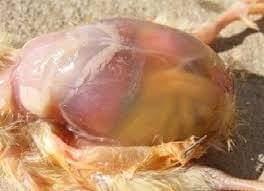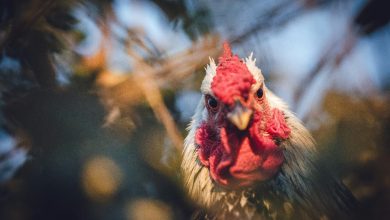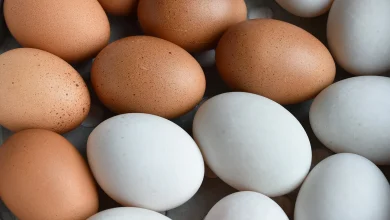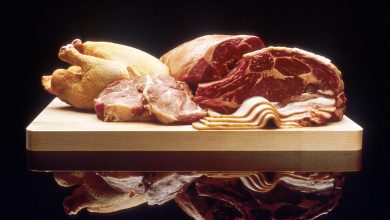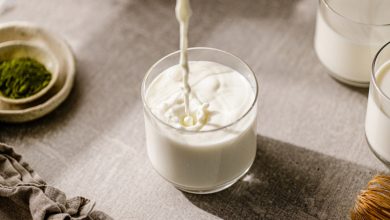Common Poultry Diseases and their Management
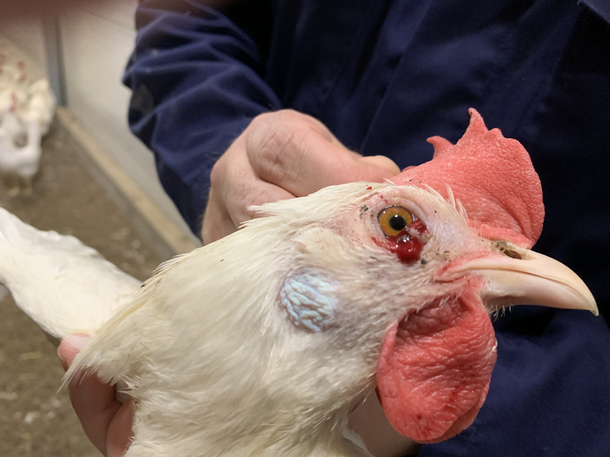
Common Poultry Diseases and their Management
Dr. Ankit Sharma*, Dr. Anil Kumar and Dr. Sumit Gangwar
Department of Livestock Production Management, GBPUAT, Pantnagar, Uttarakhand, India
Introduction: In 2018, the Indian poultry market comprising of broilers and eggs was worth INR 1,750 billion. The market is further projected to reach INR 4,340 billion by 2024, growing at a CAGR of 16.2% during 2019-2024. Today, India is the one of the world’s largest producer of eggs and broiler meat. India ranks 3rd in egg and 7th in chicken meat production in the world (Watt Executive Guide, 2015).
Among the livestock sector Poultry industry contributes for about 1 per cent of the national GDP and about 14% of the Livestock GDP. Growth rates in egg (4-6% per annum) and broiler production (8-10% per annum) in India during the last 40 years. The growth rate of layer market is 6-7 percent per annum and broiler market is 8-10 percent per annum.
BACTERIAL DISEASES:
1) Salmonellosis: caused by Salmonella pulloram. Clinical signs: Hatched chicks are often found dead. Chicks are depressed and huddled together and go off feed. Some show Some show whitish diarrhoea which stick to the vent with omphalitis. In severely affected flocks some birds may show lameness and nervous signs due to organism localising in these areas. In adults, disease remains subclinical. The organism frequently localises in the ovaries resulting in low egg production and hatchability.
Treatment:
Multivitamin therapy must be provided as supportive therapy. Furazolidone can be provided in feed for 10 days and in water furaltadone can be provided for 6 to 7 days. Brooder temperature can be increased.
Control:
Removing the carrier birds, purchase bird only from flocks known to be free of disease. Incubate and hatch egg free from disease.
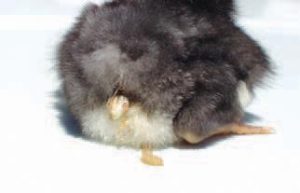
2) Colibacillosis: caused by E. coli. Clinical signs: Air sacculitis- normally seen in 6-9 weeks of age. Colisepticemia- This is an acute systemic infection, onset is sudden, chicks die in good physical condition. This can affect bird of any age. Enteritis- Necrotic enteritis, chicken exhibit diarrhea, dehydration. Salpingitis- Embryos die before hatching or some die after hatching. In chronic cases drop in egg production. Coligranuloma- Granuloma of liver, duodenum, and mesentry.

Omphalitis- Mushy chick disease
Treatment: Broad spectrum antibiotics with supportive vitamin therapy. Control: Manitain high standard of management. Avoid overcrowding, dry, dusty conditions. Avoid built up of ammonia. Supply clean chlorinated water. Bird should be fed well balanced diet. Remember pelleted feed has fewer E. coli than mash. Avoid faecal contamination of egg. Broiler breeder hen vaccinated at 6-12 weeks of age, repeated at 14-18 weeks of age.
Treatment: Broad spectrum antibiotics with supportive vitamin therapy. Control: Manitain high standard of management. Avoid overcrowding, dry, dusty conditions. Avoid built up of ammonia. Supply clean chlorinated water. Bird should be fed well balanced diet. Remember pelleted feed has fewer E. coli than mash. Avoid faecal contamination of egg. Broiler breeder hen vaccinated at 6-12 weeks of age, repeated at 14-18 weeks of age.
3) Infectious coryza: caused by Hamophilus paragallinarum Clinical signs: Oedema of face with conjunctivitis. Serous or mucosal discharge. Swollen wattles more evident in males. Lower respiratory tract infection causing rales. Drop in egg production. Foul odour detected in a flock which become chronic.
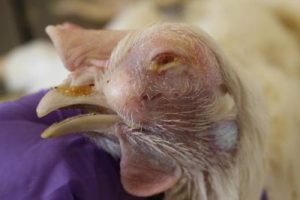
Treatment: Sulphas are effective. Streptomycin and erythromycin can be given in drinking water.
Control: Dispose of infected or recovered bird. Practise all in all out management. Vaccination can be done at 16 weeks of age. Two injactions given about 4 week apart before 20 weeks of age.
VIRAL DISEASES:
1) Fowl Pox: Caused by Avi poxvirus. Characterized by eruption and scab like lesions on the skin, combs, wattles and diphtheritic lesions in the mouth and the upper part of trachea.

Clinical signs:
1. Cutaneous form: There are local inflammation of featherless parts of skin, sometimes
2. Feather follicles with formation of nodules. Lesions have area of inflammation at the base and eventually covered by scab like lesions.
3. Diphtheritic form: Lesions appear on areas covered with mucous membrane. Diphtheritic membrane covering the ulcerated areas.
Treatment: No specific treatment. Where secondary infection is likely to occur, prophylactic medication with broad spectrum antibiotic for 3-5 days is recommended.
Control:
Vaccination is only effective.
Pigeon pox vaccine: Administered by feather follicle metghod at day old. Repeat at 3 months of age.
Fowl pox vaccine: It is given by wing stab method. It can be used from day old to 3 months of age.
2) Ranikhet disease: Caused by Paramyxovirus.
Clinical signs: a. Doyle’s form (digestive): Incubation period is 5-6 days, sudden death recorded, respiration increased, death by prostration, watery greenish diarrhoea, muscular tremors, spasm, torticollis, paralysis of legs and wings. Mortality is usually 90%.

b. Beach’s form (pneumo encephalitis): Respiratory distress, coughing and gasping, diarrhoea not observed, paralysis of legs, wings and torticollis. Egg production falls or stops. Mortality is usually 10%. c. Beaudette’s form (pneumoencephalitis and respiratory): Mostly in adults marked by cough and rarely gasping. Egg production falls or stops. Birds may not return to normal production.
d. Hitchner’s form: It is unapparent in adult birds. Respiratory signs may not clear, mortality negligible, nervous sign are not recorded.
Control: Best way is vaccination. However, vaccination cannot be considered as an alternatice to good management practices, biosecurity or good hygiene. LaSota and B1 most widely used vaccines. Vaccination: Day old chicks with F1 vaccine-7th day, RDVK strain can be given after 5th week, 28-30 day- LaSota in drinking water. RD vaccination at 7th or 8th week. RD booster between 16th or 18th week.
3) Avian Influenza (Bird Flu): Cuased by type A influenza virus. Subtype H5N1 has caused most outbreaks.
Clinical signs: Signs are variable. It can also be manifest as respiratory, enteric, reproductive or nervous system disease. Decreased food consumption and drop in egg production are some of earliest signs. Signs are coughing, sneezing, ruffled feathers, swollen heads, nervous signs and diarrhea. In some cases bird may die without clinical signs.
Prevention and control: Prevent direct contact with free flying birds and protect domestic poultry from contact with the faeces of wild birds. Avoid live markets and educate employees about danger posed by these markets.
4) Infectious Laryngo-Trachitis: It is caused by Herpesvirus
Clinical signs: Nasal discharge, coughing, gasping and moist rales. Characteristic posture of extending the neck and open mouth breathing.
Treatment: No drug is shown to be effective.
Control: Use of biosecurity measure, rodents and dog control should be done. Vaccination done at 1-3 day of age in high-risk areas.
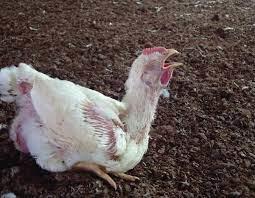
PARASITIC DISEASES:
1) Coccidiosis:
It is caused by group of protozoan parasites.
Clinical signs: Symproms vary with species of coccidian. Eimeria tenella causes cecal coccidiosis. It is severe disease causes blood droppings, high mortality, reduced weight gain and emaciation. E. necatrix causes intestinal coccidiosis. It is also harmful. Droppings contain blood, mucus and fluid. E. brunetti is found in lower part of intestine, neck of ceca, colon and rectum. It is less serious. E. maxima is moderately harmful and causes poor weight gain, diarrhea. E. acervulina is also moderately harmful. There is reduction in rate of weight gain.
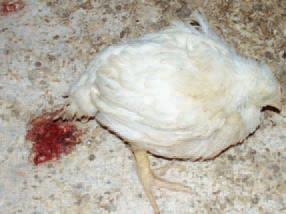
Treatment: Most commonly used drugs are Sulphas, Amprolium Hydrochloride, Monensin, Salinomycin, Clopidol etc.
Control: Broilers- continuous medication of anticoccidial drugs.
Breeders- high level of coccidiostat during first eight week.
Layer- housed in cages, high level of coccidiostat during growing period while chickens are raised on litter.
Cocci vac: This allows immunity development through controlled exposure.
2) Worm Infestation: Internal parasitic worms are common in poultry and will always be present in small numbers. However, when present in excess they can seriously affect the health and productivity of birds.
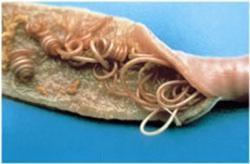
Control: Medicines such as vermex, carbon tetrachloride, tetrachilorethylene and piperazine citrate can be used.
3) External Parasites: There are many different external parasities harboured by poultry. The commonest are mites, fleas, lice and ticks.
Symptoms: Chickens are restless and nervous, peck at their own feathers, have pale combs and wattles and there is low egg production.
Control: Tick, lice, and flea powder should be rubbed into the feathers and skin of the birds. When each batch of birds is cleared spray the entire house and surrounding ground with malathion or any suitable pesticide. A regular spray of creosote will kill these pests and, at the same time, preserve the structure of the house.
NUTRITIONAL DEFICIENCY DISEASES:
Vitamin A: Chicks- wobbly gait, deposits of urates in kidney, pustules in mouth. Hens- reduced egg production, nutritional roup.
Vitamin D3, Ca and P: Leg deformity, soft bone reduced growth, ricket, poor egg production and hatchability.
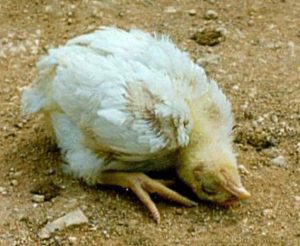
Vitamin E: Encaphalomalacia and exudative diathesis.
Thiamine: Birds sitting on flexed legs, with the neck in a stargazing position (wry neck), polyneuritis. iboflavin: Curled toe paralysis Manganese: Perosis
METABOLIC DISEASES:
1) Gout: Characterized by presence of high level of uric acid in the blood. Deposition of urates on the surface of various internal organs or joints (especially hock joint).
Causes:
Kidney dysfunction leads to hyperuricaemia, dehydration, excessive dietary calcium or calcium: phosphorus imbalance, vitamin A deficiency, increased intake of protein, intake of excessive amount of salt.
Clinical signs: In articular gout, joints are much swollen, with deposition of masses of chalk-like material. Usually wing and leg joints are affected. Affected bird cannot move and so die of starvation. Articular gout occurs mostly in male birds but visceral gout occurs both in male and female.
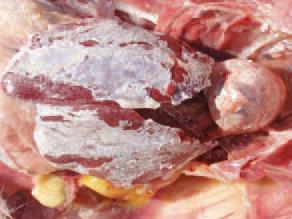
Prevention and control:
Avoid feeding of high level of calcium in advance of sexual maturity. Reduce high level of protein. Increase maize, and formulate the feed. Give plenty of water containing electrolytes.
2) Ascitis:
Accumulation of fluid in the abdominal cavity of chickens.
Clinical signs:
It may show itself a sudden death. Mortality is greatest after 4 weeks. Affected birds are smaller than
normal and depressed with ruffled feather. They have pale head, shrunken comb, feather lose their bright white sheen.
Treatment:
There is no effective treatment for ascitis. Frusemide, vitamin E and organic Se reduces mortality in ascitis.
Control:
Reduce feed intake or use very low energy feed. Use mash rather than pelleted feed. Prevent chilling of birds, ensure adequate ventilation, avoid dust and ammonia. Na in feed should not exceed 2000 ppm. Minimize toxin contamination of feed.
